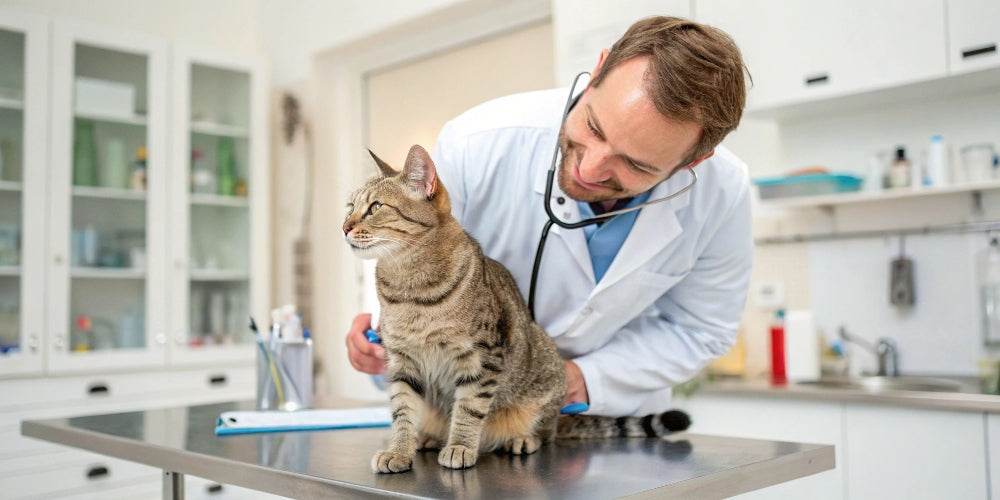
Spaying a Cat: Everything You Need to Know
Although heat is a natural stage for our cat, it has been proven that sterilizing the pet can prevent the onset of many diseases In the long run. In the wild, a cat can become pregnant several times, which is beneficial for her. However, domestic cats often don't give birth throughout their lives. It is in these cases that their bodies can develop cancerous tumors in their breasts. Spaying a cat can reduce the animal's chances of developing this disease by 95%.
In this article, we explain everything you need to know about the process of spaying a cat. We answer the most frequently asked questions, such as how to spay a cat, how much it costs to spay a cat, can a cat in heat be spayed, and what care is required for a newly spayed cat. Read on for more information!
How do you spay a cat?
Spaying a cat is a common operation that involves remove the sexual reproductive organsIn the case of female cats, the ovaries and uterus are removed—although in some cases, only the ovaries are necessary. This is done through a small longitudinal incision on or below the left side. Spaying a cat is not a painful procedure and is very simple. As is normal, the cat will be anesthetized during the operation, and during recovery, the veterinarian will provide her with painkillers, anti-inflammatories, and even antibiotics, which you should administer periodically to reduce postoperative discomfort. This process generally takes no more than three days.
At what age can a cat be spayed?
To answer the question of at what age a cat can be spayed, consider the following. It is best to do it before the first heat.In this case, the chances of reducing the occurrence of breast cancer are 95%. As time passes, the risk of developing this disease increases. According to specialists, the chances of reducing the appearance of tumors decrease to 85% between the first and second heat cycle. Therefore, the operation should be performed before the cat reaches sexual maturity and is capable of having kittens. This usually occurs between four and six months of age. This stage is usually very easy to recognize, especially because the cat usually meows frequently and quite intensely. Some veterinary centers recommend spaying the cat. from 12 weeks after birth.
How much does it cost to spay a cat?
One of the most frequently asked questions is how much it costs to spay a cat. Of course, there is no single answer, since It all depends on the law of supply and demand. So, depending on the veterinary center you go to, you may find different prices. In some cases, the price ranges between €70 and €160, but it can also go up to €280. As we said, it all depends on the center. Another thing to keep in mind when spaying your cat is that you'll need to perform a blood test beforehand to check her health and whether she can undergo surgery. This test generally costs €35.
Can a cat in heat be spayed?
The answer is yesHowever, some veterinary centers consider it better to wait until after this stage has passed, as the pet's reproductive system may present certain peculiarities. During heat, the system undergoes changes due to the increase in estrogen, for example, in the lining of the uterus—or endometrium—as it gains volume and cells multiply, increasing blood flow. This means there's a greater risk of bleeding and the recovery process will be longer. There's also the possibility that the cat could tear, and the tissue could become more fragile. For this reason, veterinarians recommend waiting until the cat has passed this heat stage.
When can a cat be spayed after giving birth?
There are some owners who prefer to wait to spay their pet until after she has had her first litter—usually, the cat gives birth to about four kittens in this first litter. In these cases, when can a cat be spayed after giving birth? It is best to set a date for the operation. from two months after birth, to ensure your pet's health. Keep in mind that your cat will need a few weeks to recover, as you can read here.
How long does it take for a spayed cat's stitches to fall out?
When answering the question of how long it takes for a spayed cat's stitches to fall out, keep the following in mind. First of all, it's essential that you take care of her to prevent the stitches from opening. Typically, the cat will need to rest for 5 days; however, her wound will heal in about a week. the stitches will fall between the second and third month.
Care for a newly spayed cat
It's essential to take care of your furry friend once you've spayed her to avoid complications. Therefore, you must ensure that she doesn't jump or make any forced movements that could open her stitches. We recommend the following:
- Prevent your pet from jumping or straining.
- Perform 3 cures a day with disinfectants.
- Provide painkillers or anti-inflammatories and antibiotics for the first few days, as directed by your veterinarian.
- Put a bodysuit or Elizabethan collar on him to protect the wound.
- Change their diet to a diet for neutered cats (with energy restrictions). You can find specific foods for them.
Changes after spaying a cat
Spaying your cat also causes a change in her temperament and metabolism. This occurs due to the reduction in sex hormones, and these are some of the most common changes after spaying a cat:
- Female cats may be more affectionate.
- The tendency to want to leave the house decreases.
- They may gain weight because they may lose the ability to regulate the amount of food they eat. Therefore, it is recommended to monitor the amount of food they are given.
- Decrease in activity level.
- Increased sensitivity in the urinary tract, which can lead to urinating in inappropriate places and more frequently, even causing bleeding. In these cases, you should consult a veterinarian.


